By simplifying the process used to make a promising type of solar cell, A*STAR researchers have also improved the device’s performance1. The discovery may lead to better manufacturing methods for the commercialization of solar cells that rely on light-harvesting compounds known as perovskites.
The power conversion efficiencies of perovskite solar cells have risen rapidly from just 3.8 per cent in 2009 to over 20 per cent today. These low-cost materials are also relatively easy to process into devices using solutions of chemicals.
For example, one of the leading perovskites — methylammonium lead iodide — is typically formed by coating a solution of its precursor, lead iodide, on to a substrate with a titanium dioxide layer. This is dipped into a solution of methylammonium iodide, which reacts with lead iodide to produce the perovskite. The lead iodide is usually heat-dried before the dipping step, to remove residual solvent.
Jie Zhang and colleagues at the A*STAR Institute of Materials Research and Engineering have now tested this thermal drying method against two alternative treatments.
When they heat-dried the lead iodide and dipped it into methylammonium iodide, almost 20 per cent of the lead iodide was not converted into perovskite. Using electron microscopy, the team found that the drying step had formed coarse, densely-packed crystals that were difficult for methylammonium iodide to penetrate.
In contrast, removing residual solvent by washing the lead iodide with another solvent called dichloromethane, followed by blow-drying, formed flat crystals that allowed better penetration of methylammonium iodide, leaving only four per cent of lead iodide unreacted.
Unexpectedly, the researchers got the best results with no treatment at all. Simply dipping the fresh lead iodide film into methylammonium iodide ensured that more than 99 per cent of it reacted to form perovskite. “The surprising finding is that using the wet film directly for conversion — the simplest and most straightforward method — yields the best performance and consistency needed for practical applications,” says Zhang.
The team used this direct approach to make photovoltaic cells with a power conversion efficiency of up to 15.6 per cent (see image). Those that had been rinsed with dichloromethane reached efficiencies of around 13.75 per cent, while the heat-dried samples yielded just 11.2 per cent, with a much wider variation in performance. “The process of forming perovskite from the as-deposited films is highly suitable for volume manufacturing of solar cells using roll-to-roll printing,” says Zhang.
The researchers plan to apply this simpler method to making larger photovoltaic cells and modules, in order to assess their performance and longevity.
Reference(s):
Publication: Changyun Jiang, Siew Lay Lim, Wei Peng Goh, Feng Xia Wei, Jie Zhang. Improvement of CH3NH3PbI3Formation for Efficient and Better Reproducible Mesoscopic Perovskite Solar Cells. ACS Applied Materials & Interfaces, 2015
Story: The Agency for Science, Technology and Research (A*STAR)














Comments